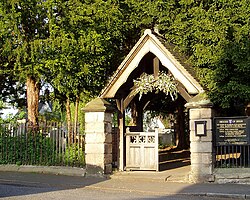Ockbrook
| Ockbrook | |
| Derbyshire | |
|---|---|
 Lane leading to Ockbrook | |
| Location | |
| Grid reference: | SK424360 |
| Location: | 52°55’12"N, 1°22’20"W |
| Data | |
| Population: | 7,335 (2011) |
| Post town: | Derby |
| Postcode: | DE72 |
| Dialling code: | 01332 |
| Local Government | |
| Council: | Erewash |
| Parliamentary constituency: |
Mid Derbyshire |
Ockbrook is a village in Derbyshire, almost contiguous with the village of Borrowash, from which it is separated only by the A52. The population of the two together was recorded as 7,335 in 2011. Ockbrook is about five miles east of Derby.
The main streets of the village are Bare Lane, Green Lane and Moor Lane, which form one continuous road through the village. The quickest route between two points in the village is often by an alley known locally as a 'gitty': these were originally footpaths through fields and have survived the encroachment of housing by mutating into high walled or fenced alleyways between the buildings and gardens of the new (and old) developments. Several of the footpaths leading out of the village over fields lead of from gitties.
History
There is evidence of human activity in Ockbrook from as far back as the Mesolithic period (~8000 BC) in the form of two bifacial cores of flint. A small greenstone axe head attests to Neolithic activity (4000 - 2500BC, but no archaeological evidence has yet been discovered of Bronze Age activity in the village.[1]
A Romano-British aisled building was excavated at Littlehay Grange Farm between 1994 and 1997, finding sherds of Ancaster Breedon scored ware and Aylesford-Swarling Pottery, a one-piece brooch, an Iron Age coin of silver dating to between 40 BC and 10 AD, and an Iron Age ring headed pin or spike.[1] Three Roman period farmsteads have been located.
The Domesday Book of 1086 records that the manor was held before the Conquest by Toki (probably a Dane by desent).[1] The entry reads:
"...In Ockbrook Tochi had four carucates of land (assessed) to the geld, land for four ploughs. There are now ten villeins and two bordars having three ploughs and four rent paying tenants rendering 14 shillings. There are five acres of meadow, woodland for pannage one league (unit)|league in length and half a league wide. In King Edward’s day worth £4 now 40shillings belonging to the Bishop of Chester...".[1]
The land came to join the extensive holdings of Geoffrey Alselin, and around 1130 it was divided between two sons of Sir Ralph Halselin whence half descended to the Bardolfs of Wormegay (who sold it to the Foljambe's c1420) and half to Serlo de Grendon who granted it to Dale Abbey. At the Reformation, these shares were largely broken up amongst the freeholders, notably the Battelles, Harpurs, Keyes (of Hopwell) and Wilmots (of Chaddesden).[2]
In 1750 the Moravian Church established a settlement] here, one of only three remaining in the country. This was on the edge of the old village and separate from it. The buildings are Georgian red brick and two of them, the Manse (1822) and the chapel (1751–1752) are grade II listed.
From the early 19th century, middle-class families from Derby and Long Eaton took advantage of the fragmented landowning pattern to acquire land and build elegant villas.[2] Also during this period, work diversified to include four silk glove makers, four shoemakers, and a straw bonnet maker.[3] In more recent times, extensive new housing developments have turned Ockbrook into a commuter dormitory for Derby.
Parish church

The Church of England parish church is All Saints' Church.
All Saints' became the parish church between c1550 and c1600: before this Ockbrook it was a chapelry of Elvaston
The font is Saxon]] or Norman. The tower is late twelfth century, and the broached spire]] is thirteenth century[2] The oak chancel screen dates from c1520.
Sport
- Cricket: Ockbrook & Borrowash Cricket Club, who moved to the current ground on Victoria Avenue in 1898
- Football: Ockbrook Football Club
Outside links
| ("Wikimedia Commons" has material about Ockbrook) |

- Ockbrook & Borrowash Community Information
- Ockbrook Football Club
- Ockash Trust
- Discover Derbyshire and the Peak District – Ockbrook
- Ockbrook Parish Council
- Ockbrook School
References
- ↑ 1.0 1.1 1.2 1.3 Palfreyman, Alan (1999). Ockbrook Before Domesday. Derbyshire: Ockbrook and Borrowash Historical Society.
- ↑ 2.0 2.1 2.2 Craven, Maxwell (1996). The Illustrated History of Derby's Suburbs. Breedon Books Publishing Co Ltd. ISBN 1-85983-031-5.
- ↑ Derbyshire Villages. Countryside Books. 2002. ISBN 978-1853067488.
- Johnson, M.:
- 'A French Parson at Ockbrook' (2001) ISBN 1-873064-09-8
- 'Lords of the Manor of Ockbrook: Archives 1583 to 1605' (Ockbrook & Borrowash Record Society; Greenway Publishing, 1994) {{ISBN|1-873064-06-3
- 'Ockbrook and Its Parson Samuel Hey 1810–52' (1991) ISBN 1-873064-02-0
- 'Yeomen of Elizabethan Ockbrook: Archives of the Sixteenth Century' (Ockbrook & Borrowash Record Society; Greenway Publishing, 1994) ISBN 1-873064-05-5
- Harnan, J W: 'A history of All Saints' Church, Ockbrook: including a brief account of the early origins of the village and parish' (1971) ISBN 0-9502209-0-6.
- Muckle, James: 'Bold Shall I Stand: The Education of Young Women in the Moravian Settlement at Ockbrook Since 1799' (Ockbrook School, 1999) ISBN 0-9536600-0-1.
- Hutton, J. E.: 'History Of The Moravian Church' (2004) ISBN 1-4191-2425-0
- Ockbrook in Old Picture Postcards, J. Lec Smith, Europese Bibliotheek B.V., Uitgeverij Boekhandel Antiquariaat, February 1985, ISBN 90-288-2983-0.
- The Plumpton Letters and Papers (Camden Fifth S.), Joan Kirby (Editor), Cambridge University Press, 16 January 1997, ISBN 0-521-57394-7. See references to Ockbrook at [1]